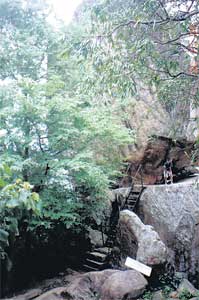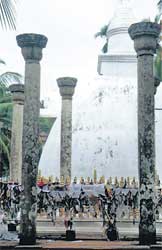The king is on a pleasure hunt. As he stands near a mango tree with bow and arrow, he sees a yellow robed imposing person on top of a rock. He orders the king to come near him. The king is bewildered. “Who is there to order me like this,” he wonders. "We are 'samanas.' We have come from Jambudipa," the sage says.
 |
| Mihindu guhawa |
The king puts down his bow and arrow, approaches the sage and worships him.
This significant meeting took place at Missaka mountain (Mihintale) on the full moon day of Poson (June) in the year 247 before the birth of Christ (B.C). The king was Tissa – later known as Devanampiya Tissa – (250-210 B.C). The sage was Arahat Mahinda, son of the Indian Emperor Asoka. His mission was to introduce Buddhism to
Sri Lanka.
The conversation that followed between the King and the Sage has been described as the first intelligence test in history.
It went thus:
Sage (Pointing to a mango tree): What name does this tree bear, O king?
King: This is called a mango tree.
Sage: Is there another, other than this mango tree?
King: There are many other mango trees, sir.
Sage: Are there other trees besides this mango and other mango trees?
King: There are many trees, sir, but those are not mango trees.
Sage: Are there, beside the other mango trees and those which are not mango trees, yet other trees?
King: There is this mango tree, sir.
The Sage was satisfied that the King was an intelligent person who could understand and grasp the Dhamma, the teachings of the Buddha. He then delivered the first sermon to the King and his retinue. Starting with the King, the people embraced Buddhism in large numbers after listening to the sermon.
The event was not merely a religious one. It was the beginning of a new civilization. It marked the commencement of the Sinhala Buddhist architecture. Stupas began to adorn the capital city, Anuradhapura and its environs. Intricate sculpture began to evolve. Dwellings for monks were built. The art of writing began to develope. Buddhism inspired the Sinhalese painter and the writer.
Places of worship
Over the centuries, the historic meeting place of the King and the Sage at Mihintale has been preserved. The Ambastala Dagaba has been built there. The exact spot on which the King stood is covered with a slab of stone and is called the 'Candrakanti pashana.’ It is enclosed by a railing. Stone pillars around the Dagaba indicate that it had been a 'vata-da-ge' – a stupa with a roof.
The imposing 'Aradhana gala' – the rock on which the Arahat Mahinda and the five disciples had been spotted – is directly in front.
On the left is the 'Maha Seya' – the biggest of the stupas at Mihintale. The 'Mihindu Seya' is believed to contain the ashes of Arahat Mahinda.
 |
| Ambasthala Dagaba |
Walking to the east from Ambasthala Dagaba, one reaches the 'Mihindu guhava' – the cave with a stone bed where Arahat Mahinda spent most of his time. He must have preferred this location due to the peaceful environment around. Situated on one bank of the mountain, the view from the cave is most beautiful.
'Indikatu Seya' and 'Katu Seya' are two other places of worship standing close to each other right at the bottom of Mihintale.
It is an easy climb to the places of worship. The main flight of 1,840 broad steps well sheltered by 'araliya' trees have been maintained over the years and takes one from the foot of the mountain to Ambastala. To the right is the 'Kantaka Cetiya,' famous for its 'vahalkada' (gateway) sculptures.
Profusely ornamented, these range from bas-reliefs to images in the round. Among them are the 'mura gal' (guardstones), 'koravakgal' (balustrades), 'sandakada pahan' (moonstones) and 'pun kalas' (full pots). There are paintings too around the Kantaka Cetiya.
In and around Mihintale too there are many places to see including caves, inscriptions and ruins of buildings which may have been dwelling places of monks.
The Brahmi inscriptions of Mihintale are the earliest form of Sinhala writing. The earliest to decipher these was British archaeologist H. C. P. Bell. The credit of restoring the Mihintale places of worship goes to renowned archaeologist Professor Senerat Paranavitana, Commissioner of Archaeology.
Devotees from all parts of Sri Lanka flock to Anuradhapura and Mihintale to celebrate Poson. They first visit the 'Atamasthana' – the eight places of worship in Anuradhapura and then proceed to Mihintale. | 

